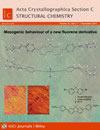Formation of a diiron-(μ-η1:η1-CN) complex from acetonitrile solution.
IF 0.7
4区 化学
Q4 CHEMISTRY, MULTIDISCIPLINARY
Acta Crystallographica Section C Structural Chemistry
Pub Date : 2024-09-01
Epub Date: 2024-08-08
DOI:10.1107/S2053229624007058
引用次数: 0
Abstract
The activation of C-C bonds by transition-metal complexes is of continuing interest and acetonitrile (MeCN) has attracted attention as a cyanide source with comparatively low toxicity for organic cyanation reactions. A diiron end-on μ-η1:η1-CN-bridged complex was obtained from a crystallization experiment of an open-chain iron-NHC complex, namely, μ-cyanido-κ2C:N-bis{[(acetonitrile-κN)[3,3'-bis(pyridin-2-yl)-1,1'-(methylidene)bis(benzimidazol-2-ylidene)]iron(II)} tris(hexafluorophosphate), [Fe2(CN)(C2H3N)2(C25H18N6)2](PF6)3. The cyanide appears to originate from the MeCN solvent by C-C bond cleavage or through carbon-hydrogen oxidation.
从乙腈溶液中生成二铁(μ-η1:η1-CN)复合物。
过渡金属络合物对 C-C 键的活化作用一直备受关注,而乙腈(MeCN)作为一种毒性相对较低的氰源,在有机氰化反应中备受关注。一种二铁端对μ-η1:η1-CN 桥接配合物是通过对一种开链铁-NHC 配合物(即μ-氰基-κ2C)的结晶实验得到的:N-bis{[(acetonitrile-κN)[3,3'-bis(pyridin-2-yl)-1,1'-(methylidene)bis(benzimidazol-2-ylidene)]iron(II)} tris(hexafluorophosphate), [Fe2(CN)(C2H3N)2(C25H18N6)2](PF6)3。氰化物似乎是通过 C-C 键裂解或碳氢氧化作用从 MeCN 溶剂中产生的。
本文章由计算机程序翻译,如有差异,请以英文原文为准。
求助全文
约1分钟内获得全文
求助全文
来源期刊

Acta Crystallographica Section C Structural Chemistry
CHEMISTRY, MULTIDISCIPLINARYCRYSTALLOGRAPH-CRYSTALLOGRAPHY
CiteScore
1.60
自引率
12.50%
发文量
148
期刊介绍:
Acta Crystallographica Section C: Structural Chemistry is continuing its transition to a journal that publishes exciting science with structural content, in particular, important results relating to the chemical sciences. Section C is the journal of choice for the rapid publication of articles that highlight interesting research facilitated by the determination, calculation or analysis of structures of any type, other than macromolecular structures. Articles that emphasize the science and the outcomes that were enabled by the study are particularly welcomed. Authors are encouraged to include mainstream science in their papers, thereby producing manuscripts that are substantial scientific well-rounded contributions that appeal to a broad community of readers and increase the profile of the authors.
 求助内容:
求助内容: 应助结果提醒方式:
应助结果提醒方式:


